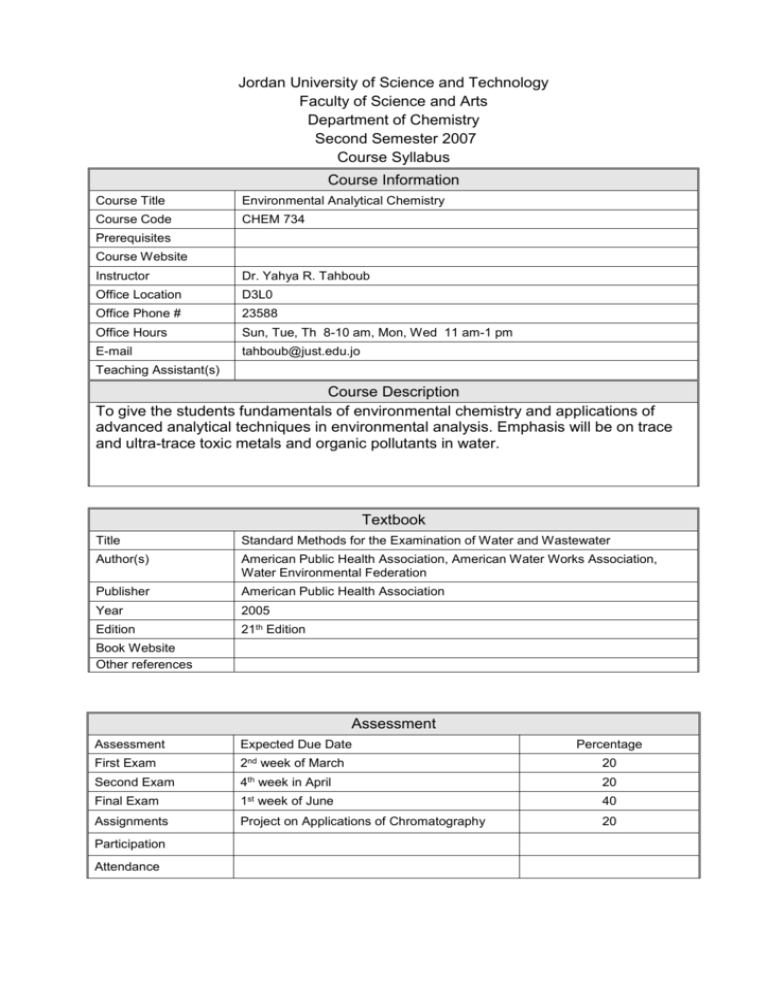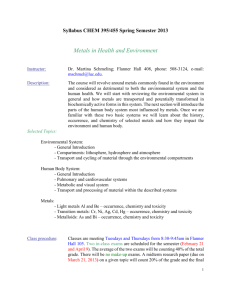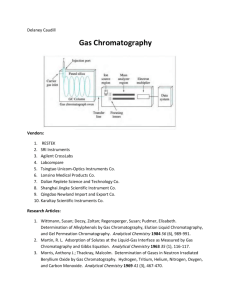Jordan University of Science & Technology
advertisement

Jordan University of Science and Technology Faculty of Science and Arts Department of Chemistry Second Semester 2007 Course Syllabus Course Information Course Title Environmental Analytical Chemistry Course Code CHEM 734 Prerequisites Course Website Instructor Dr. Yahya R. Tahboub Office Location D3L0 Office Phone # 23588 Office Hours Sun, Tue, Th 8-10 am, Mon, Wed 11 am-1 pm E-mail tahboub@just.edu.jo Teaching Assistant(s) Course Description To give the students fundamentals of environmental chemistry and applications of advanced analytical techniques in environmental analysis. Emphasis will be on trace and ultra-trace toxic metals and organic pollutants in water. Textbook Title Standard Methods for the Examination of Water and Wastewater Author(s) American Public Health Association, American Water Works Association, Water Environmental Federation Publisher American Public Health Association Year 2005 Edition 21th Edition Book Website Other references Assessment Assessment Expected Due Date First Exam 2nd week of March 20 Second Exam 4th week in April 20 Final Exam 1st week of June 40 Assignments Project on Applications of Chromatography Participation Attendance Percentage 20 Course Objectives Percentage 1. Development of Regulatory Limits 10% 2. Understanding Fundamentals of Environmental Chemistry 10% 3. Understanding Parameters of Environmental Methodology 10% 1-3 Validation of Environmental Analytical Methods 10% 4. Analytical Techniques Involved in Environmental Methods 20% 5. Analysis of Toxic Metals in Water and waste Water 15% 6. Analysis of Organic Pollutants in Water and Waste Water 15% 7. Sample Preparation in Environmental Analysis 5% 1-7 Method Development for Environmental Analysis 5% Teaching & Learning Methods Class periods will be a mixture of theory, analysis, demonstration, and discussion. I believe in the activelearner approach. You are required to read. Learning Outcomes: Upon successful completion of this course, students will be able to Related Objective(s) Reference(s) 1 Establishments limits of Regulatory 2 Quality control assurance 3 Environmental Pollution 4 Analytical Techniques Environmental Analysis 5 Analysis of Toxic Metals Standard Methods Ch 3 6 Analysis of Organic Pollutants Standard Methods Ch 6 7 Sample Preparation Environmental Methods and Quality Chemistry and in for Handouts Standard Methods Ch 1 Handouts Handouts Handouts Useful Resources 1. 2. 3. 4. 5. 6. P. Patnaik, Handbook of Environmental Analysis, CRC 1997 L. R. Snyder, J. J. Kirkland and J. L. Glajch, Practical HPLC Development, Wiley 1997. H. J. McNair and J. M. Miller, Basic Gas Chromatography, Wiley 1998. J. H. Gross, Mass Spectrometry: A Text Book, Springer-Verlag 2004 J and M. Rose, Mass Spectrometry for Chemists and Biochemists, Cambridge University Press 1996. C. Dass Practice of Biological Mass Spectrometry, Wiley 2001. Course Content Week 1 Topics Chapter in Textbook (handouts) Introduction to Environmental Chemistry and Environmental analysis Handout 2-3 4-6 7-8 9-10 11-13 14-15 16 Assignments Exams Regulatory limits for chemical pollutants in water: regulatory limits, type of water, suitable regulatory analytical method, basis for regulatory limits . Environmental methodology: statistics, glossary, quality assurance, quality control, quality assessment, data quality, method development and evaluation, collection and preservation of samples, laboratory occupational health and safety, waste minimization and disposal. Handouts Standard Methods, Ch 1 Analytical Methods in Environmental Analysis: Atomic Absorption Spectrometry, Inductively Coupled Plasma, Gas Chromatography, Liquid Chromatography Handouts Metals: introduction, QA/QC, preliminary treatment of samples, metals by atomic absorption spectrometry (flame, cold-vapor, electrothermal), metals by plasma emission spectrometry, metals by ICP-MS, metals by anodic stripping Standard Methods, Ch 3 Individual Organic compounds: introduction, QA/QC, constituent concentration by gas extraction volatile organic compounds, trihalomethanes and chlorinated organic solvents, extractable base/neutrals and acids, phenols, polychlorinated biphenyls (PCBs), polynuclear aromatic hydrocarbons (PAHs), pesticides Standard Methods, Ch 6 Sample Preparation: Dissolution of inorganic samples, Liquid-Liquid Extraction, Solid Phase Extraction, Solid Phase Microextraction Handouts Method Development in Environmental Analysis Handouts A set of problems will be assigned at somewhat irregular intervals but will always be due before class on each due date. Policy on late homework: late homework will not be accepted without a serious or compelling reason. There will be two exams and a comprehensive final. If an exam is missed for a documented serious and compelling reason (e.g., signed doctor's excuse), a make-up exam will be held at a time and place of the instructor's discretion. Equation sheets will be provided during the exams. Please bring only pencils and calculators to the exams. Tentative Exam Schedule: 1. Two Majors (Class Tests): 2 x 20% = 40% I. First Exam: Tuesday II. Second Exam: Tuesday March (2nd week), 2007. April (4th week), 2007. III. Project 20% 2. Final Exam: May 26-June 4, 2007 40% TOTAL Attendance 100% Academic dishonesty of any form will not be tolerated. University policies on cheating and plagiarism (see Students' Guide) will be strictly enforced. You are required to attend all lectures. Please see me if you have an extended illness or family emergency. You must initial the attendance sheet on the side blackboard every day so that I have a quick check of who is missing. Workload Graded Exams ……………. Participation No points, but students are highly encouraged to participate in the discussion. Laboratory None Projects None Disclaimer The instructor reserves the right to make changes to this course and its administration as reasonable and necessary. …………….






